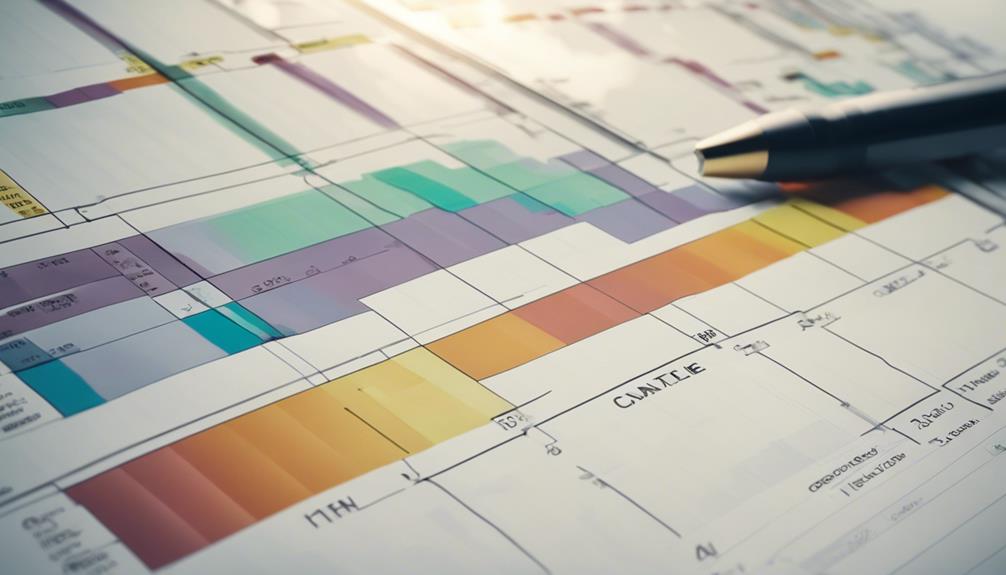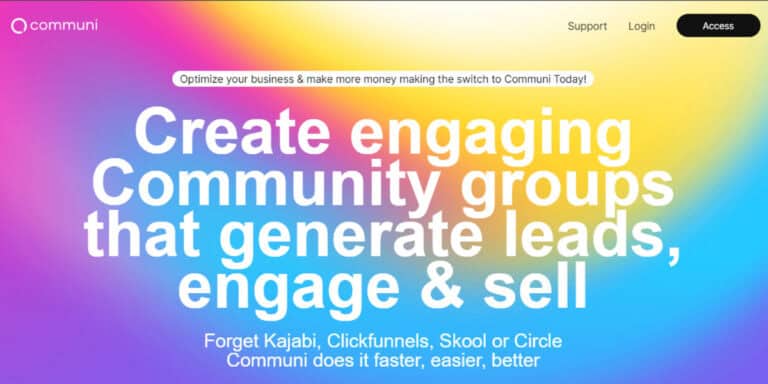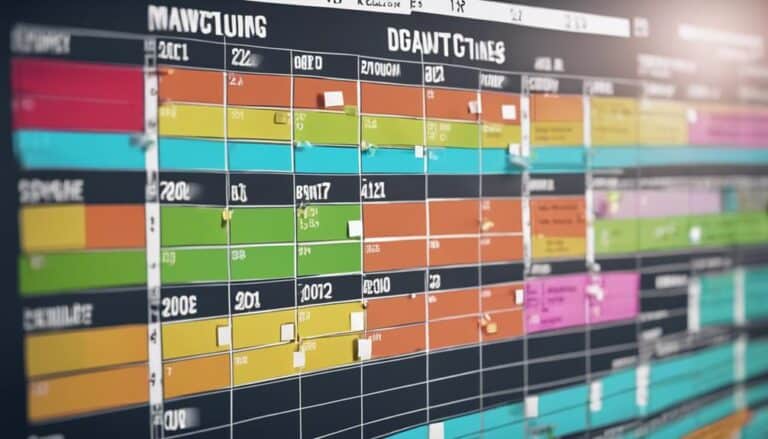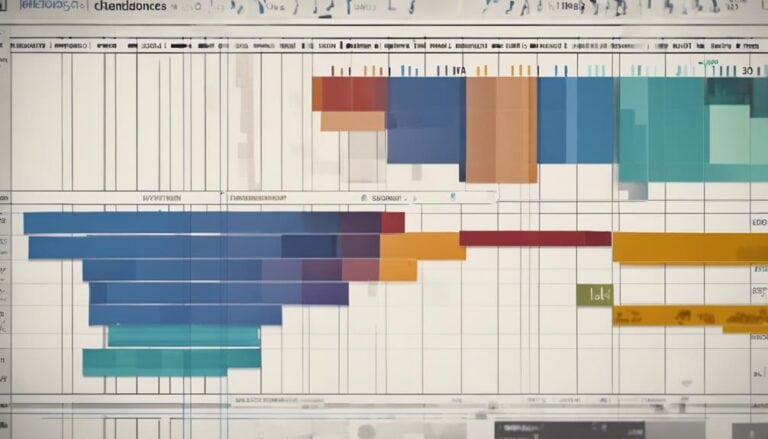When it comes to effective project management tools, the Gantt chart stands out for its ability to streamline project timelines and tasks.
The simplicity of its visual layout offers a comprehensive view of project progress, but what truly sets it apart is its impact on team dynamics and project outcomes.
As you consider the various aspects of Gantt chart scheduling, you may find yourself intrigued by the subtle yet powerful ways it influences collaboration and decision-making within project teams.
Key Takeaways
- Streamlines project timelines and dependencies for efficient tracking and coordination.
- Provides clear visual representation aiding in effective communication and decision-making.
- Enhances team efficiency, collaboration, and accountability through clear task allocation.
- Enables effective resource allocation, realistic timeline setting, and early identification of potential delays.
Enhanced Project Tracking
Enhancing project tracking through Gantt chart scheduling offers a streamlined approach to monitoring project timelines and task dependencies, aiding in efficient resource allocation and timely completion. Gantt charts provide a visual representation of the project schedule, allowing you to easily identify the critical path tasks that are crucial for project success.
By understanding task dependencies, you can allocate resources effectively, ensuring that each task is completed in the correct order to prevent delays. The visual nature of Gantt charts simplifies complex project information, making it easier for you to coordinate with team members and stakeholders.
This visual overview fosters better communication within the team, enhancing collaboration and ensuring everyone is on the same page regarding project progress. With Gantt chart scheduling, you can effectively manage project timelines, dependencies, and resource allocation, leading to successful project outcomes through improved tracking and coordination.
Clear Visual Overview
Transitioning from the enhanced project tracking capabilities enabled by Gantt chart scheduling, the current subtopic 'Clear Visual Overview' emphasizes the pivotal role of visual representations in project management.
Gantt chart software provides a clear visual overview of project timelines, task dependencies, and resource allocation. This visual representation aids in easily identifying overlaps, critical tasks, and potential bottlenecks within the project schedule.
Project management software utilizing Gantt charts enhances communication, fosters accountability, and improves the understanding of project progress for all team members. The visual roadmap offered by Gantt charts simplifies complex project information, making it easier to set deadlines and prioritize tasks effectively.
Utilizing Gantt charts ensures that project managers and team members have a comprehensive view of the project's progression, aiding in better decision-making and successful project completion.
Increased Team Efficiency
When using Gantt charts for scheduling, you can clearly allocate tasks to team members and ensure everyone knows their responsibilities.
This clarity in task allocation leads to improved timeline management, allowing team members to prioritize effectively and meet deadlines efficiently.
Clear Task Allocation
Assigning specific tasks to team members within a Gantt chart schedule greatly enhances team efficiency by clarifying responsibilities and deadlines. Clear task allocation ensures that everyone knows what they need to work on, reducing confusion and enhancing accountability.
Here are some key points on the importance of clear task allocation in Gantt chart scheduling:
- Enhances team efficiency
- Reduces confusion and enhances accountability
- Leads to smoother project execution
- Provides a visual representation of task allocation
- Promotes collaboration, coordination, and timely completion of project milestones
Effective task allocation in Gantt chart scheduling not only streamlines workflow but also fosters a sense of ownership and teamwork among team members.
Improved Timeline Management
Clear task allocation in Gantt chart scheduling ensures efficient timeline management, increasing team productivity through visual representation of project timelines and dependencies. Gantt charts in projects help team members understand task durations, project dependencies, and critical deadlines at a glance. By providing a structured overview of project timelines, Gantt charts enhance team efficiency by enabling easy tracking of progress, resource allocation, and task prioritization. This visual representation allows for quick identification of bottlenecks, facilitating adjustments to schedules to maintain project momentum. Moreover, the clarity offered by Gantt charts streamlines communication and fosters collaboration among team members. Utilizing Gantt charts in project management significantly contributes to improved timeline management and overall team efficiency.
| Task Durations | Project Dependencies | Visual Representation |
|---|---|---|
| Clearly defined | Identify critical paths | Simplifies understanding |
| Enables tracking progress | Highlight task sequences | Facilitates resource allocation |
| Supports prioritization | Manage interdependencies | Enhances communication |
Highlighted Task Relationships
When highlighted task relationships are emphasized in a Gantt chart, you gain a clearer understanding of task dependencies.
This clarity leads to improved project coordination as you can see how tasks relate to one another.
Clear Task Dependencies
Highlighting task relationships in Gantt charts facilitates a comprehensive understanding of project sequences and critical paths. When task dependencies are clear in Gantt charts, project managers can efficiently allocate resources and adjust schedules for optimal workflow. This clarity helps in identifying critical paths and potential bottlenecks, enhancing project scheduling.
The visual representation of relationships between tasks aids in grasping the sequence of activities within a project. By emphasizing task dependencies, Gantt charts improve communication among team members, illustrating how tasks interconnect and impact project timelines.
- Clear task dependencies aid in efficient resource allocation.
- Gantt charts help identify critical paths in project schedules.
- Project managers can adjust schedules for optimal workflow.
- Improved communication among team members.
- Visualization of task relationships aids in understanding project sequences.
Improved Project Coordination
Improving project coordination through Gantt chart scheduling involves emphasizing task relationships and dependencies to enhance resource allocation and time management efficiency. By utilizing a Gantt chart in the project management process, managers can clearly see the interconnectivity of tasks, aiding in the identification of critical paths and potential delays.
These highlighted task relationships in Gantt charts serve as essential project management tools, offering a visual representation of the project's flow. This visual aid enables managers to allocate resources effectively and streamline project execution. Understanding the sequence of tasks through the chart promotes efficient project planning and execution, ultimately leading to improved project coordination and successful project outcomes.
Enhances Time Management
Utilizing Gantt charts in project management enhances time management by visually emphasizing task relationships, aiding in prioritizing and scheduling tasks effectively for improved project efficiency. Gantt charts in project planning help in identifying task dependencies, optimizing resource allocation, and streamlining project timelines. Here's how they enhance time management:
- Highlight task relationships for better understanding of project timelines.
- Aid in prioritizing tasks efficiently.
- Identify critical paths and potential bottlenecks.
- Assist in optimal resource allocation.
- Provide a structured overview of tasks, deadlines, and interdependencies.
Simplified Data Management
Gantt charts streamline data management by visually presenting project timelines and task dependencies, aiding in effective project planning. By incorporating task dependencies into the chart, it becomes easier to understand the sequence of tasks and how they impact one another. This visual representation offers a clear overview of project progress, milestones, and critical tasks, allowing for better decision-making regarding resource allocation and task prioritization.
With Gantt charts, managing complex project information becomes more efficient as overlaps and dependencies are illustrated, helping you stay organized and on track. Additionally, these charts reduce the need for extensive status reports, as teams can quickly grasp task timelines and progress visually. This simplicity in data management not only enhances project planning but also improves communication and collaboration among team members. Embracing the streamlined data management approach of Gantt charts can significantly boost the efficiency and effectiveness of your project management processes.
Effective Resource Allocation
Efficiently assigning tasks to team members based on their skills and availability is crucial for maximizing project productivity and success. Effective resource management plays a significant role in ensuring tasks are allocated optimally.
Here are key points to consider for effective resource allocation in Gantt chart scheduling:
- Utilize team members' skills: Assign tasks to team members based on their expertise to ensure efficient completion.
- Consider availability: Take into account the availability of team members when assigning tasks to avoid bottlenecks.
- Ensure even distribution: Distribute tasks evenly among team members to prevent overloading and ensure a balanced workload.
- Prioritize tasks: Use Gantt charts to prioritize tasks based on resource availability, reducing conflicts and delays.
- Focus on task completion: Proper resource allocation leads to improved project efficiency, timely task completion, and better overall project outcomes.
Realistic Timeline Setting
To ensure project timelines are feasible and tasks are accurately scheduled, realistic timeline setting is crucial in Gantt chart scheduling. Setting realistic deadlines is essential for project managers and teams to effectively use Gantt charts for planning and monitoring progress. By incorporating realistic timeframes into the Gantt chart, project managers can ensure that tasks are achievable within the allocated time and resources. This practice not only enhances team productivity but also aids in keeping track of project milestones and avoiding bottlenecks.
Gantt charts serve as valuable tools for project managers to visualize project timelines and dependencies. When realistic deadlines are set within these charts, it becomes easier to allocate resources efficiently and prioritize tasks effectively. Project managers can identify potential delays early on and make necessary adjustments to keep the project on track. By using Gantt charts with realistic timeline settings, project managers and teams can improve project management efficiency and increase the chances of project success.
Team Collaboration and Alignment
Enhancing team collaboration and alignment is a critical aspect of utilizing Gantt chart scheduling effectively in project management. Gantt charts offer a visual representation of tasks, deadlines, and dependencies, fostering teamwork and cohesion. Here are some key ways in which Gantt charts enhance team collaboration and alignment:
- Clear Project Timelines: Gantt charts outline project timelines, helping team members understand the sequence of tasks and project milestones.
- Defined Responsibilities: By clearly assigning responsibilities in the chart, team alignment is achieved as members know their roles and contributions.
- Facilitates Communication: Team members can communicate effectively based on the information displayed in the Gantt chart, ensuring everyone is on the same page.
- Promotes Collaboration: Collaborative decision-making is encouraged as team members coordinate efforts using the shared project schedule.
- Tracking Progress: Alignment is strengthened through the shared understanding of project milestones and progress tracking, keeping the team focused on common goals.
Frequently Asked Questions
What Makes an Effective Gantt Chart?
To create an effective Gantt chart, ensure visual representation for project progress, task allocation, resource management, and timeline tracking. It helps in organizing tasks, tracking progress, managing resources efficiently, and staying on schedule for successful project completion.
What Are the Advantages of Gantt Chart in Scheduling Management?
In time management, Gantt charts aid in visual representation, resource allocation, tracking progress, and identifying task dependencies. They streamline scheduling by illustrating overlaps and milestones, enhancing project planning efficiency and team coordination.
What Is the Effectiveness of Gantt Chart?
In managing your projects, Gantt charts excel at time management, visual representation, task dependencies, resource allocation, and project tracking. They streamline your schedule, clarify task relationships, optimize resource use, and monitor progress effectively.
What Does Gantt Chart Do in Scheduling?
In time management, a Gantt chart tracks tasks, allocates resources, visualizes projects, and maps dependencies. It enhances scheduling efficiency, aiding in project organization and progress monitoring. This tool streamlines complex information, fostering clarity and productivity.
Conclusion
In conclusion, the effectiveness of Gantt chart scheduling lies in its ability to streamline project management processes, enhance team collaboration, and provide a clear visual representation of project timelines.
By utilizing this powerful tool, project managers can track progress, allocate resources efficiently, and ensure project success.
The intricate dance of tasks and timelines depicted in a Gantt chart serves as a roadmap to project completion, guiding teams towards their goals with precision and clarity.





